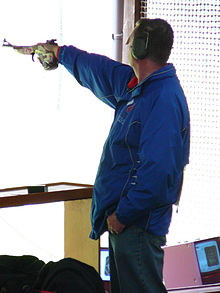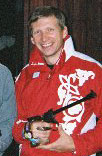ISSF 50 meter pistol
 | |
| Men | |
|---|---|
| Number of shots | 60 + 20 |
| Olympic Games | 1896-2016 |
| World Championships | Since 1900 |
| Abbreviation | FP |
The 50 meter pistol, formerly and unofficially still often called free pistol, is one of the ISSF shooting events. It provides the purest precision shooting among the pistol events, and is one of the oldest shooting types, dating back to the 19th century and only having seen marginal rule changes since the 1936. Most of the changes concern distance (30m, 50m, 50 Yards), caliber (.22 .22lr .44CF), type of pistol (revolver only, revolver or pistol, any pistol), and time allowed (16 hours, 6 hours, 3 hours, 2 hours, 1 hour and 15 minutes) and, most recently, format of the finals (carry over scores, start from zero, amount of shots fired in the finals). The target of this event has never changed since 1900, and the distance since 1912. Competitors have been using the single shot 22 rim-fire pistol since 1908. The sport traced back to the beginning of indoor flobert Pistol parlor shooting in Europe during the 1870s, which in turn traced back to 18th century pistol dueling.
The pistol used must be in caliber .22 Long Rifle ammunition, may only be loaded with one round at a time, and have conventional "open" or "iron" sights (i.e. optical and laser sights are not allowed). It must also be operated by one hand and not supported by any other part of the shooter's body. Apart from that, there are practically no rules for the pistol, explaining the former name of the event. Trigger weight may be as low as the shooter pleases, the grip may be designed in any way to enhance comfortable ergonomic fit as long as it does not touch the wrist for support, and there are no restrictions on size and weight. Precision pistols with long barrels, grips fitted to the shooter's hand, very light trigger pull, etc., are often themselves called free pistols.
The course of fire is 60 shots within a maximum time of two hours. The target is the same as in 25 metre center-fire pistol, and with double the distance this explains the lower result level. Five hundred seventy out of the maximum 600 is considered a world-class result. The current world record, 583, was achieved in the World shooting Championships Granada in 2014 by the South Korean Jin Jong-oh.
Most shooters excelling in 50 metre pistol also compete at the same level in 10 metre air pistol, a similar precision event.
World Championships, Men
World Championships, Men Team
World Championships, total medals
| 1 | 30 | 16 | 14 | 60 | |
| 2 | 14 | 6 | 6 | 26 | |
| 3 | 13 | 4 | 3 | 20 | |
| 4 | 8 | 8 | 7 | 23 | |
| 5 | 7 | 2 | 3 | 12 | |
| 6 | 4 | 8 | 5 | 17 | |
| 7 | 4 | 2 | 1 | 7 | |
| 8 | 3 | 14 | 17 | 34 | |
| 9 | 3 | 9 | 4 | 16 | |
| 10 | 3 | 5 | 3 | 11 | |
| 11 | 2 | 2 | 0 | 4 | |
| 12 | 1 | 2 | 0 | 3 | |
| 13 | 1 | 2 | 0 | 3 | |
| 14 | 1 | 1 | 2 | 4 | |
| 15 | 1 | 1 | 1 | 3 | |
| 16 | 1 | 0 | 3 | 4 | |
| 17 | 0 | 4 | 2 | 6 | |
| 18 | 0 | 3 | 3 | 6 | |
| 19 | 0 | 2 | 4 | 6 | |
| 20 | 0 | 1 | 4 | 5 | |
| 21 | 0 | 1 | 2 | 3 | |
| 22 | 0 | 1 | 0 | 1 | |
| 22 | 0 | 1 | 0 | 1 | |
| 24 | 0 | 0 | 2 | 2 | |
| 24 | 0 | 0 | 2 | 2 | |
| 24 | 0 | 0 | 2 | 2 | |
| 27 | 0 | 0 | 1 | 1 | |
| 27 | 0 | 0 | 1 | 1 | |
| 27 | 0 | 0 | 1 | 1 | |
| 27 | 0 | 0 | 1 | 1 | |
| Total | 96 | 95 | 94 | 285 | |
World Cup Final
ISSF has introduced a series of World Cup competitions for Olympic shooting events in 1986, and the final has been held at the end of each season since 1988.
Current world records
| Current world records in 50 metre pistol | ||||||||
|---|---|---|---|---|---|---|---|---|
| Men | Qualification | 583 | September 9, 2014 | Granada (ESP) | edit | |||
| Final | 230.1 | March 01, 2017 | New Delhi |
edit | ||||
| Teams | 1719 | September 7, 1985 | Osijek (YUG) | edit | ||||
| Junior Men | ||||||||
Olympic and World Champions
Jin Jong-oh is the only double (and triple) Olympic champion in 50 metre pistol; he is the only shooter to have won three consecutive Olympic gold medals in one event. World Championships were held annually up to the 1931 then biennially until 1954 (the current quadrennial format was introduced afterwards), which made a few long streaks possible, but after World War II few shooters have been able to win two major World-level titles (the Olympics and the World Championships); Jin is the only one to have won three or more since the World Championships intervals were changed to the current quadrennial format. Paul Van Asbroeck has won the most number of Olympic and World titles combined with seven titles (1 Olympics and 6 World titles). Torsten Ullman won six (1 Olympic, 5 World titles) over the span of 1933-1952, including four successive Championships between 1933 and 1937 (including the 1936 Summer Olympics). Wilhem Schnyder won four consecutive World Championships between 1924 and 1928. Van Asbroeck, Ullman, Huelet Benner and Jin are only ones to have held the Olympic and the World titles simultaneously.
Another rare double is that between this precision event and its direct opposite 25 metre rapid fire pistol; this has only been accomplished by Alfred Lane (completed in 1912), Torsten Ullman (1939), Huelet Benner (1952) and Pentti Linnosvuo (1964), with Lane (in one Olympics) and Linnosvuo using only Olympic titles. Benner, on the other hand, is the only shooter with two titles in both events. Several athletes have won 50 metre pistol and 10 metre air pistol titles; Jin is the ony person to have done so at the (single) Olympics.
ISSF World Cup Series has been held since 1986 with the World Cup Final at the end of the season since 1988; Ragnar Skanåker and Jin are the only two to have won this competition as well as the Olympic and World titles. Skanåker's 1993 World Cup Final victory was achieved at the age of 59; it was also his last international victory.
The distance of the Free Pistol event was 30 metre initially. This was because 30 metre was used in the German Championship, the most important competition at the time. Starting from the 1900 Olympics, which also served as the first world championship for Free Pistol, the distance was set at 50 metre. Both the distance and the target remained the same to this day, with the exception of the 1908 Olympics in which the distance changed from 50 metre to 50 yards.
Free Pistol was not held between the 1920 and 1936 Olympics. This is due to the perception of the time that pistol shooters, especially in free pistol, were professionals who competed in tournaments which awarded prized money. The strict amateur status required by the IOC ran counter against UIT (ISSF) and the money and medal awarding system of the target pistol shooting competition tradition. The best shooters in the world such as Wilhelm Schnyder and his Swiss teammates with their Häuptli pistols would dominate the world championships, but were denied the chance to compete in the Olympics. With the exception of 1923 when they did not compete, from 1921 to 1939 the Swiss either won the individual or the team World titles, or both. Hitler made sure shooting was part of the 1936 program as he was eager to demonstrate his country's military might, including a brand new special designed Walther pistol for the rapid fire event.
1 The Olympic competitions in Paris also counted as the 1900 World Championships. 2 Same model as MP33. Name changed by new company owner.



